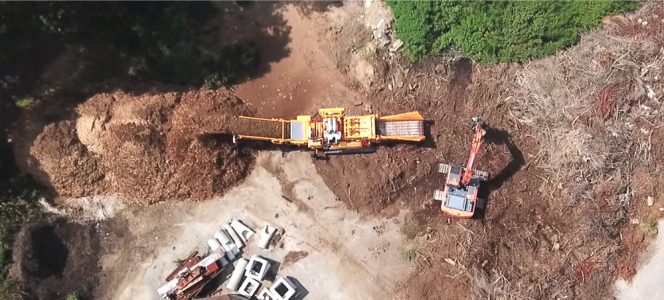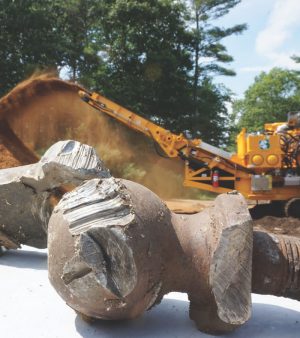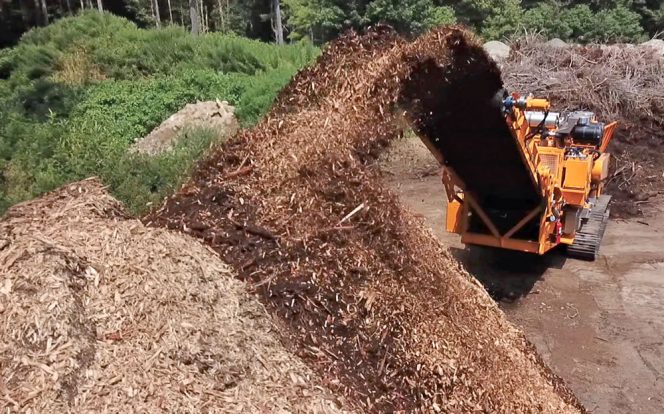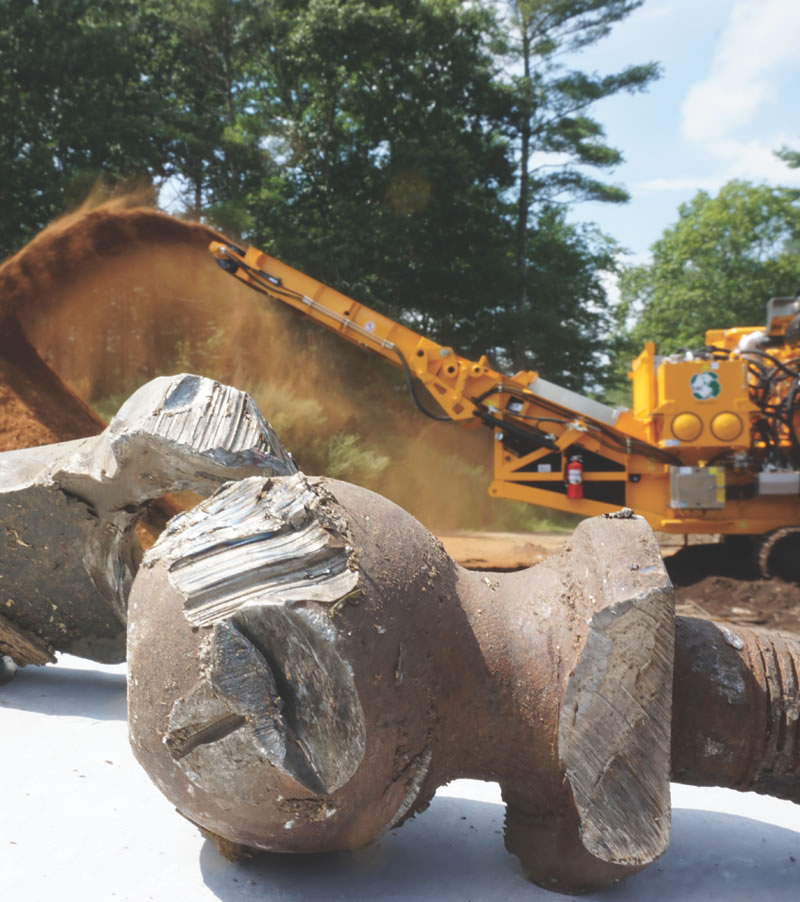A waste authority in Connecticut uses a mobile grinder to process brush and other yard trimmings for 12 member municipalities.
Joe Gallagher
BioCycle November/December 2018
 The Southeastern Connecticut Regional Resource Recovery Authority (SCRRRA) was established through the state’s legislature in 1987 to serve 12 towns in the southeastern part of the state. The intent was to create long-term solutions for waste and pass value along to the residents. Under this collective model, member municipalities deliver a minimum amount of solid waste to SCRRRA’s waste-to-energy burn plant in Preston (CT) to be processed for a small fee. The Authority also manages a closed ash landfill, provides assistance for new and existing recycling programs, and offers an array of waste management services.
The Southeastern Connecticut Regional Resource Recovery Authority (SCRRRA) was established through the state’s legislature in 1987 to serve 12 towns in the southeastern part of the state. The intent was to create long-term solutions for waste and pass value along to the residents. Under this collective model, member municipalities deliver a minimum amount of solid waste to SCRRRA’s waste-to-energy burn plant in Preston (CT) to be processed for a small fee. The Authority also manages a closed ash landfill, provides assistance for new and existing recycling programs, and offers an array of waste management services.
SCRRRA’s organics recycling services include grinding brush for member municipalities at no cost and selling discounted backyard composting bins to residents. Anyone demonstrating proof of residency in one of the 12 towns can drop off brush and tree trimmings free of charge at solid waste transfer stations in or near the towns. A mobile grinder is transported to these locations to process the brush and other yard trimmings.
Educational Outreach
The Authority offers classes to residents on composting, recycling, solid waste, and household hazardous waste. Other activities include presentations, backyard composting demonstrations, a trash relay, recycling jeopardy, and school composting outreach programs. The classes cover the subject matter within a broader environmental and scientific framework. Modules are flexible depending on topic, age, and class size to engage attendees.
SCRRRA is committed to reducing contamination along every stage of the waste management process. One of its most creative tactics to instill new habits in residents is the gamification of recycling education, which includes an interactive “SCRRRA Recycling Challenge” online game. The waste sorting game lets players drag and drop various materials between the transfer station, backyard compost bin, recycling bin, garbage can, and hazardous waste options. It’s a fun way to raise the baseline understanding of “what goes where” and encourage residents to adopt new behaviors.

Anyone demonstrating proof of residency in one of the 12 towns can drop off brush and tree trimmings free of charge at solid waste transfer stations. Photos courtesy of CBI & Terex Ecotec
Yard Trimmings Processing
Many of the brush piles at the drop-off locations contain various sized materials, from small branches to large diameter wood from the local town crews. Even with household education about proper materials separation, SCRRRA deals with contaminants in the yard trimmings that are dropped off. “We’ve seen everything in the brush piles from the kitchen sinks to the steel lally columns used in basements,” explains Lenny Weise, who manages SCRRRA’s grinding operations. “Sometimes there are car parts in the brush piles.”
The Authority recently upgraded to a CBI 6800CT Horizontal Grinder, developed for wood waste recycling professionals who need to process high-volumes of materials and detect any metal mixed into piles. For example, notes Weise, a trailer hitch was hiding in a brush pile that he loaded into the grinder while working in the town of Griswold. When the hitch made contact with the rotor, electronic sensors alerted the control system and reversed the infeed. The top feed roll raised automatically and the hitch was easily located and removed. There was no damage to the machine, not even a single broken tooth, he says, and the grinder was back up and running a few minutes later.

Even with household education about proper separation, SCRRRA deals with contaminants in materials dropped off by residents — including a trailer hitch. Photos courtesy of CBI & Terex Ecotec
Metal detection systems (MDS) have been in use for a long time, but advancements and state-of-the-art precision are being built into today’s grinders. CBI’s MDS uses an accelerometer to detect and monitor the rotor’s vibration patterns, picking up the unique harmonic frequency of metal hitting metal and translating the change to a user dashboard mounted on the side of the machine. Milliseconds after tramp metal strikes the rotor, the MDS system automatically stops the rotor, raises the top feed roller, reverses the infeed, sets the engine to an idle, and goes into a controlled shutdown of the machine. This measure prevents damage to the machine before it becomes an issue.
A display screen enables the operator to set the “trip point” sensitivity on a scale of zero to five, tailoring the system to the application. The grinder can also be equipped with magnets to capture smaller bits of metal, e.g., in material coming off the discharge belt.
All of the ground yard trimmings are sold to a private compost manufacturer. Weise estimates that six of the towns each generate about 3,000 to 4,000 cubic yards (cy) of material annually, and the other six each generate 1,000 to 1,500 cy annually.

The Authority upgraded to a mobile CBI 6800CT horizontal grinder equipped with a metal detection system that monitors the rotor’s vibration patterns to pick up the harmonic frequency of tramp metal hitting the metal rotor. Photos courtesy of CBI & Terex Ecotec
He adds that in general, the towns are seeing significant improvements in brush management at their transfer stations. “The sites are neater, and they will be a lot less worried about the brush piles catching on fire,” he says.
SCRRRA’s member municipalities include East Lyme, Griswold, Groton, Ledyard, Montville, New London, North Stonington, Norwich, Preston, Sprague, Stonington, and Waterford. To learn more about SCRRRA and their various programs, visit www.scrrra.org.
Joe Gallagher is Marketing Coordinator at CBI & Terex Ecotec.










